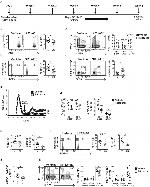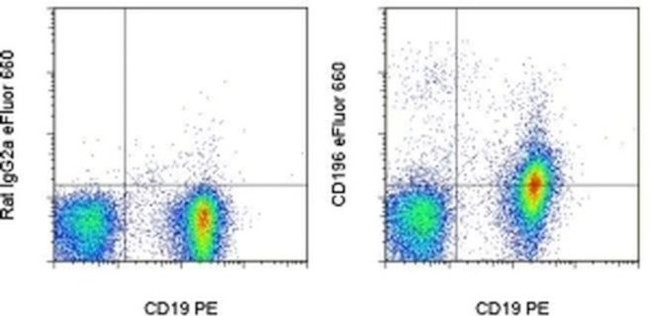Search Thermo Fisher Scientific
Invitrogen
CD196 (CCR6) Monoclonal Antibody (sirx6), eFluor™ 660, eBioscience™
FIGURE: 1 / 2
CD196 (CCR6) Antibody (50-7196-82) in Flow


Product Details
50-7196-82
Species Reactivity
Published species
Host/Isotype
Recommended Isotype Control
Class
Type
Clone
Immunogen
Conjugate
Excitation/Emission Max
Form
Concentration
Purification
Storage buffer
Contains
Storage conditions
Shipping conditions
RRID
Product Specific Information
Description: The sirx6 monoclonal antibody reacts with mouse CD196 (CCR6). CD196 is a seven transmembrane G protein-coupled receptor expressed on T, B, dendritic, NK and Langerhans cells. This CC chemokine receptor uniquely binds MIP3a/CCL20, a chemoattractant for dendritic cells, effector/memory T cells, and B cells. CD196 is also involved in host defense and inflammation at epithelial sites. Furthermore, this receptor has been implicated in Th17 differentiation and CD4+FoxP3+ regulatory T cell development.
Due to expression characteristics of some chemokine receptors (shedding, surface cleavage or intracellular cycling), we recommend a fixation step after surface staining. Refer to Applications Tested for more information.
Applications Reported: This sirx6 antibody has been reported for use in flow cytometric analysis.
Applications Tested: This sirx6 antibody has been tested by flow cytometric analysis of mouse splenocytes. Cells are surface stained, then washed with Flow Cytometry Staining Buffer, immediately fixed with IC Fixation Buffer for 20-30 minutes, and then washed with Flow Cytometry Staining Buffer prior to analysis. This can be used at less than or equal to 1 µg per test. A test is defined as the amount (µg) of antibody that will stain a cell sample in a final volume of 100 µL. Cell number should be determined empirically but can range from 10^5 to 10^8 cells/test. It is recommended that the antibody be carefully titrated for optimal performance in the assay of interest.
eFluor® 660 is a replacement for Alexa Fluor® 647. eFluor® 660 emits at 659 nm and is excited with the red laser (633 nm). Please make sure that your instrument is capable of detecting this fluorochome.
Excitation: 633-647 nm; Emission: 668 nm; Laser: Red Laser.
Filtration: 0.2 µm post-manufacturing filtered.
Target Information
CCR6 is a member of the beta chemokine receptor family, which is predicted to be a seven transmembrane protein similar to G protein-coupled receptors. The gene is preferentially expressed by immature dendritic cells and memory T cells. The ligand of this receptor is macrophage inflammatory protein 3 alpha (MIP-3 alpha). This receptor has been shown to be important for B-lineage maturation and antigen-driven B-cell differentiation, and it may regulate the migration and recruitment of dentritic and T cells during inflammatory and immunological responses. Alternatively spliced transcript variants that encode the same protein have been described for this gene.
For Research Use Only. Not for use in diagnostic procedures. Not for resale without express authorization.
How to use the Panel Builder
Watch the video to learn how to use the Invitrogen Flow Cytometry Panel Builder to build your next flow cytometry panel in 5 easy steps.
Bioinformatics
Protein Aliases: C-C chemokine receptor type 6; C-C CKR-6; CD196; CKR6; DRY-6; KY411
Gene Aliases: CC-CKR-6; CCR-6; Ccr6; Cmkbr6; KY411
UniProt ID: (Mouse) O54689
Entrez Gene ID: (Mouse) 12458

Performance Guarantee
If an Invitrogen™ antibody doesn't perform as described on our website or datasheet,we'll replace the product at no cost to you, or provide you with a credit for a future purchase.*
Learn more
We're here to help
Get expert recommendations for common problems or connect directly with an on staff expert for technical assistance related to applications, equipment and general product use.
Contact tech support

